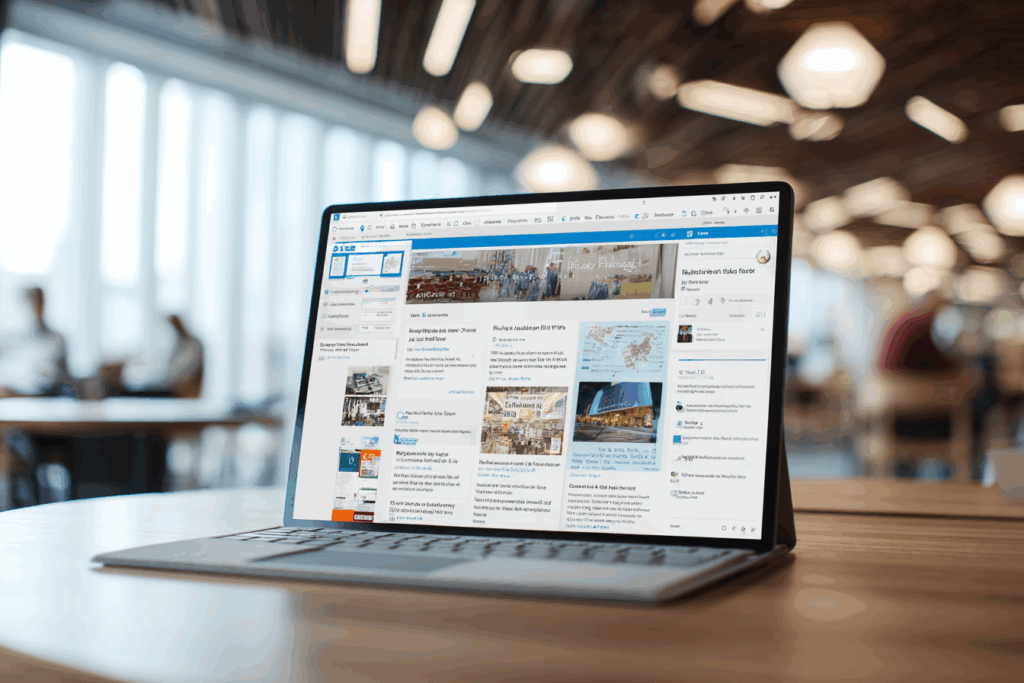
If your team still relies on a mix of local installs, shared drives, and ad hoc tools, it is time to review what Microsoft Office 365 includes and how it can simplify your workflow. The modern Microsoft 365 platform brings together the Office apps you know with secure cloud services and device management.
In this guide, we unpack Microsoft Office 365, what it includes at each plan level, how the core apps and services fit together, and how to roll it out smoothly with the right governance.
At its core, Microsoft 365 combines the familiar Office apps with cloud-based collaboration, storage, security, and management. The exact bundle depends on your chosen plan, but most business plans include desktop and web versions of Word, Excel, PowerPoint, and Outlook, along with Teams for meetings and chat, OneDrive for personal storage, and SharePoint for team sites and document libraries. You also gain Exchange Online for email, Planner, and To Do for lightweight task management, and access to a growing set of automation tools.
Licensing is per user, which lets each person install the desktop apps on multiple devices and also sign in through a browser. This model suits hybrid work and supports policies that follow the user across Windows, macOS, iOS, Android, and the web.

Small and mid-sized organisations usually evaluate Business Basic, Business Standard, and Business Premium. Business Basic focuses on web and mobile apps with cloud services. Business Standard adds the full desktop Office apps. Business Premium includes everything in Standard, plus advanced security features such as device management and threat protection that help an MSP or in-house IT team enforce consistent controls.
Larger or more regulated environments often look at Microsoft 365 E3 and E5, which add deeper security, compliance, analytics, and voice options. The value is not only the individual features but the way identity, data, and devices are managed from a single tenant. When you ask what Microsoft Office 365 includes beyond apps, this central management is one of the strongest answers.
.
Every day, work still revolves around documents, spreadsheets, and presentations. The desktop versions deliver full features while the web versions support quick edits and live co-authoring. Outlook connects to Exchange Online, so email, calendars, and contacts sync across devices. The combination lets staff draft in Word, analyse in Excel, and present in PowerPoint without file chaos.
Teams brings chat, channels, meetings, as well as calling into one place. It integrates tightly with SharePoint and OneDrive, so files live with the conversation. Whiteboard supports visual sessions, and Loop components let you co-edit small blocks of content inside chats and emails. For many customers, the shift to Teams meetings and channels is the single biggest quality of life upgrade.
OneDrive provides personal cloud storage and simple sharing. SharePoint powers team sites, document libraries, and intranet pages. Versioning and permissions ensure changes are tracked and access stays controlled. This structure reduces duplicate files and supports compliance policies like retention and legal hold when needed.

With Azure Active Directory now Microsoft Entra ID, you manage user identities, multifactor authentication, and conditional access policies. Business Premium adds Intune device management so you can enroll Windows and mobile devices, push security baselines, and control app access. If you rely on a mobility workforce, this is vital for reducing risk without slowing people down.
Even smaller businesses benefit from built-in data loss prevention, sensitivity labels, encrypted email, and basic threat protection. E3 and E5 add richer tools for insider risk, advanced eDiscovery, and endpoint detection and response. When a client asks what Microsoft 365 includes for compliance, present these features as a single, integrated toolkit rather than a patchwork of point products.
Start by mapping who needs desktop apps, who can live in a browser, and who handles sensitive data. If your staff needs full desktop apps plus secure collaboration, Business Standard is the baseline. If you also want device management, conditional access, and stronger threat protection, Business Premium often pays for itself by consolidating tools. For regulated teams that must meet strict audit and discovery requirements, E3 or E5 becomes attractive.
Consider where work happens. If users move across laptops, tablets, and phones, per-user licensing ensures a consistent experience. If you are retiring a file server, SharePoint and OneDrive can replace network shares with better search and sharing controls.
Inventory mailboxes, file shares, and legacy tools. Decide what to migrate and what to archive. Use the Microsoft assessment tools to estimate effort and sequence the move. Pilot with a small group before broad rollout. Provide short guides that show how to find files in OneDrive and SharePoint, how to schedule a Teams meeting, and how to co-author in Word and Excel. Adoption hinges on simple habits, not long manuals.
An MSP like Epic IT can manage identity sync, mailbox migration, and SharePoint structure so the cutover is smooth. Ongoing support and training keep the momentum after day one.

Power Automate helps you replace manual steps with simple flows. Examples include routing a form submission to a SharePoint list, notifying a channel when a document changes, or capturing approvals with timestamps. Power Apps lets you create lightweight applications on top of Microsoft data. Even without custom apps, most teams benefit from templates that reduce routine clicks and create clear audit trails.
Viva adds employee experience modules that surface learning, topics, and insights in Teams. These modules can unify communications and knowledge for distributed teams and make onboarding easier.
Licenses are flexible, so you can scale up or down as headcount changes. Use groups to assign apps consistently and remove access when people depart. Apply retention policies that meet legal needs without hoarding data forever. Set sharing policies to balance collaboration with control. Enable backup and recovery features and consider adding third-party backup for extra assurance if your risk profile demands it.
From a resilience perspective, cloud-based mail and files reduce dependence on a single office or server. If a local outage occurs, staff can keep working from another location or device. This continuity is a key reason many customers ask again what Microsoft Office 365 includes, since the answer is more than apps. It is an operating model that supports mobility and uptime.
Epic IT designs and delivers Microsoft 365 environments that match your goals. We assess current tools, map identities and data, and recommend the right plan mix. We configure security baselines, set up Teams governance, and build SharePoint sites that reflect how your teams actually work. After launch, we provide managed support, training, and continuous improvement so you see value every month. To learn more or start a discussion, visit our services page. If you are ready to scope a migration or a security uplift, reach out to us, and we will guide the next steps.
When teams ask Microsoft Office 365 what it includes, they are often surprised by how much is already available in the plans they own. The platform covers productivity, collaboration, storage, security, and device management in a unified way. Choosing the right plan and rolling it out with simple governance gives you a modern workplace without unnecessary complexity. With the right partner, you can move quickly, keep data safe, and help staff focus on work rather than tools.
It includes Office apps for desktop and web, Teams for chat and meetings, Exchange Online for email, OneDrive for personal storage, SharePoint for team content, and built-in security and management features. The exact bundle depends on the plan you choose.
Business plans include multifactor authentication, conditional access, device management with Intune in Business Premium, and data protection features like sensitivity labels and data loss prevention. Higher tiers add advanced threat protection and compliance tools.
Yes. OneDrive and SharePoint store files in the cloud with versioning, permissions, and search. You can organise team sites to mirror departments and projects and set sharing rules that fit your governance needs.
Many small businesses begin with Business Standard for desktop apps and cloud services. If you want stronger security and device management, Business Premium is a common upgrade. Larger or regulated teams often evaluate E3 or E5.
We assess your environment, plan migration, configure security and access, set up Teams and SharePoint, and train staff. After launch, we provide managed services and ongoing improvement so your investment keeps delivering value.